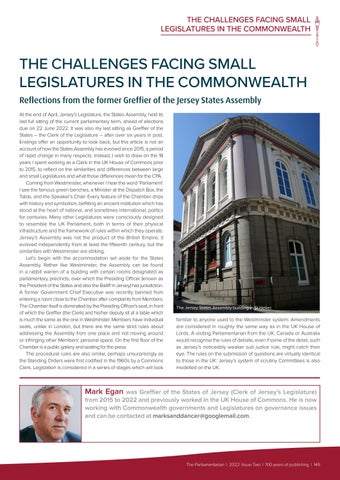THE CHALLENGES FACING SMALL LEGISLATURES IN THE COMMONWEALTH
THE CHALLENGES FACING SMALL LEGISLATURES IN THE COMMONWEALTH Reflections from the former Greffier of the Jersey States Assembly At the end of April, Jersey’s Legislature, the States Assembly, held its last full sitting of the current parliamentary term, ahead of elections due on 22 June 2022. It was also my last sitting as Greffier of the States – the Clerk of the Legislature – after over six years in post. Endings offer an opportunity to look back, but this article is not an account of how the States Assembly has evolved since 2015, a period of rapid change in many respects. Instead, I wish to draw on the 18 years I spent working as a Clerk in the UK House of Commons prior to 2015, to reflect on the similarities and differences between large and small Legislatures and what those differences mean for the CPA. Coming from Westminster, whenever I hear the word ‘Parliament’ I see the famous green benches, a Minister at the Dispatch Box, the Table, and the Speaker’s Chair. Every feature of the Chamber drips with history and symbolism, befitting an ancient institution which has stood at the heart of national, and sometimes international, politics for centuries. Many other Legislatures were consciously designed to resemble the UK Parliament, both in terms of their physical infrastructure and the framework of rules within which they operate. Jersey’s Assembly was not the product of the British Empire, it evolved independently from at least the fifteenth century, but the similarities with Westminster are striking. Let’s begin with the accommodation set aside for the States Assembly. Rather like Westminster, the Assembly can be found in a rabbit warren of a building with certain rooms designated as parliamentary precincts, over which the Presiding Officer (known as the President of the States and also the Bailiff in Jersey) has jurisdiction. A former Government Chief Executive was recently banned from entering a room close to the Chamber after complaints from Members. The Chamber itself is dominated by the Presiding Officer’s seat, in front of which the Greffier (the Clerk) and his/her deputy sit at a table which is much the same as the one in Westminster. Members have individual seats, unlike in London, but there are the same strict rules about addressing the Assembly from one place and not moving around or infringing other Members’ personal space. On the first floor of the Chamber is a public gallery and seating for the press. The procedural rules are also similar, perhaps unsurprisingly as the Standing Orders were first codified in the 1960s by a Commons Clerk. Legislation is considered in a series of stages which will look
The Jersey States Assembly building in St Helier.
familiar to anyone used to the Westminster system. Amendments are considered in roughly the same way as in the UK House of Lords. A visiting Parliamentarian from the UK, Canada or Australia would recognise the rules of debate, even if some of the detail, such as Jersey’s noticeably weaker sub judice rule, might catch their eye. The rules on the submission of questions are virtually identical to those in the UK: Jersey’s system of scrutiny Committees is also modelled on the UK.
Mark Egan
was Greffier of the States of Jersey (Clerk of Jersey’s Legislature) from 2015 to 2022 and previously worked in the UK House of Commons. He is now working with Commonwealth governments and Legislatures on governance issues and can be contacted at marksanddancer@googlemail.com.
The Parliamentarian | 2022: Issue Two | 100 years of publishing | 149
